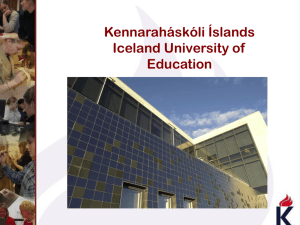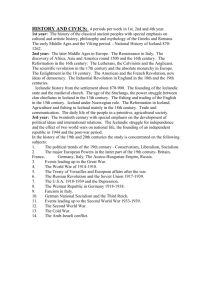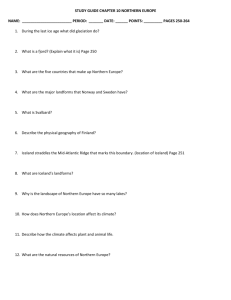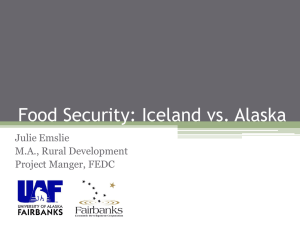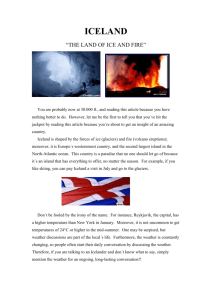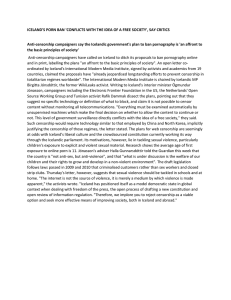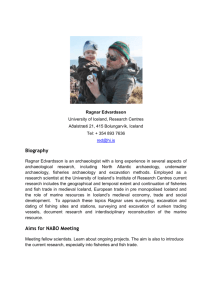Evaluating Nature and Wilderness in Iceland Thóra Ellen Thórhallsdóttir
advertisement
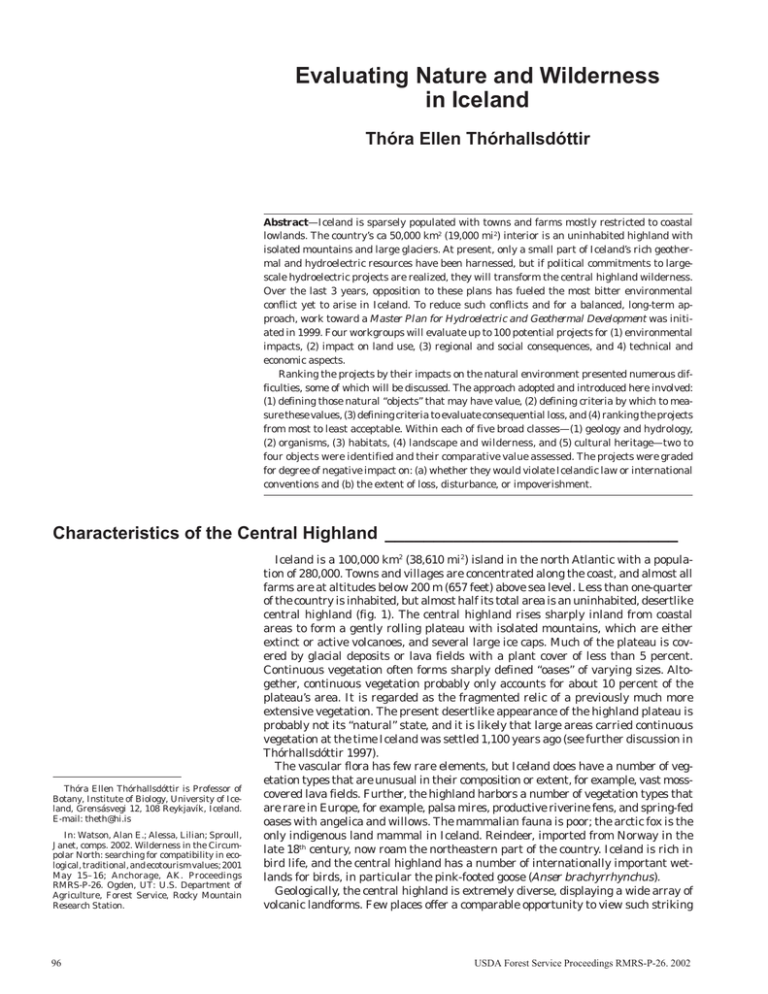
Evaluating Nature and Wilderness in Iceland Thóra Ellen Thórhallsdóttir Abstract—Iceland is sparsely populated with towns and farms mostly restricted to coastal lowlands. The country’s ca 50,000 km2 (19,000 mi2) interior is an uninhabited highland with isolated mountains and large glaciers. At present, only a small part of Iceland’s rich geothermal and hydroelectric resources have been harnessed, but if political commitments to largescale hydroelectric projects are realized, they will transform the central highland wilderness. Over the last 3 years, opposition to these plans has fueled the most bitter environmental conflict yet to arise in Iceland. To reduce such conflicts and for a balanced, long-term approach, work toward a Master Plan for Hydroelectric and Geothermal Development was initiated in 1999. Four workgroups will evaluate up to 100 potential projects for (1) environmental impacts, (2) impact on land use, (3) regional and social consequences, and 4) technical and economic aspects. Ranking the projects by their impacts on the natural environment presented numerous difficulties, some of which will be discussed. The approach adopted and introduced here involved: (1) defining those natural “objects” that may have value, (2) defining criteria by which to measure these values, (3) defining criteria to evaluate consequential loss, and (4) ranking the projects from most to least acceptable. Within each of five broad classes—(1) geology and hydrology, (2) organisms, (3) habitats, (4) landscape and wilderness, and (5) cultural heritage—two to four objects were identified and their comparative value assessed. The projects were graded for degree of negative impact on: (a) whether they would violate Icelandic law or international conventions and (b) the extent of loss, disturbance, or impoverishment. Characteristics of the Central Highland ______________________________ Thóra Ellen Thórhallsdóttir is Professor of Botany, Institute of Biology, University of Iceland, Grensásvegi 12, 108 Reykjavík, Iceland. E-mail: theth@hi.is In: Watson, Alan E.; Alessa, Lilian; Sproull, Janet, comps. 2002. Wilderness in the Circumpolar North: searching for compatibility in ecological, traditional, and ecotourism values; 2001 May 15–16; Anchorage, AK. Proceedings RMRS-P-26. Ogden, UT: U.S. Department of Agriculture, Forest Service, Rocky Mountain Research Station. 96 Iceland is a 100,000 km2 (38,610 mi2) island in the north Atlantic with a population of 280,000. Towns and villages are concentrated along the coast, and almost all farms are at altitudes below 200 m (657 feet) above sea level. Less than one-quarter of the country is inhabited, but almost half its total area is an uninhabited, desertlike central highland (fig. 1). The central highland rises sharply inland from coastal areas to form a gently rolling plateau with isolated mountains, which are either extinct or active volcanoes, and several large ice caps. Much of the plateau is covered by glacial deposits or lava fields with a plant cover of less than 5 percent. Continuous vegetation often forms sharply defined “oases” of varying sizes. Altogether, continuous vegetation probably only accounts for about 10 percent of the plateau’s area. It is regarded as the fragmented relic of a previously much more extensive vegetation. The present desertlike appearance of the highland plateau is probably not its “natural” state, and it is likely that large areas carried continuous vegetation at the time Iceland was settled 1,100 years ago (see further discussion in Thórhallsdóttir 1997). The vascular flora has few rare elements, but Iceland does have a number of vegetation types that are unusual in their composition or extent, for example, vast mosscovered lava fields. Further, the highland harbors a number of vegetation types that are rare in Europe, for example, palsa mires, productive riverine fens, and spring-fed oases with angelica and willows. The mammalian fauna is poor; the arctic fox is the only indigenous land mammal in Iceland. Reindeer, imported from Norway in the late 18th century, now roam the northeastern part of the country. Iceland is rich in bird life, and the central highland has a number of internationally important wetlands for birds, in particular the pink-footed goose (Anser brachyrrhynchus). Geologically, the central highland is extremely diverse, displaying a wide array of volcanic landforms. Few places offer a comparable opportunity to view such striking USDA Forest Service Proceedings RMRS-P-26. 2002 Evaluating Nature and Wilderness in Iceland Thórhallsdóttir Figure 1—Inhabited areas of Iceland (light gray) and the approximate boundaries of the central highland (black line). examples of the action of all major geomorphological agents—volcanoes, glaciers, water, and wind. Central Highland as Wilderness ____________________________________ Historical and archaeological evidence shows that farming was attempted in parts of the highland first after the settlement of Iceland (9th to 11th century A.D.), but proved unsustainable and was soon abandoned (Thórarinsson 1974). Most of the highland has never been inhabited or farmed, although it has traditionally been used for summer grazing for sheep. The Icelandic wilderness differs from its closest latitudinal counterparts in Scandinavia, America, and Greenland, in that it does not, nor has it ever had, an indigenous population. The three words used to describe the central highland each reflects the Icelanders’ sentiments towards the inland. The two traditional words are “óbyggdir,” meaning “uninhabited land,” and “öræfi,” meaning “wasteland.” The third word is used in the recent Icelandic wilderness protection legislation; “víderni,” meaning “a land of distant views.” The central highland rises behind Icelanders in a literal and in an abstract sense. Farms often form a single line on the lowlands, facing either the sea or a valley bottom. Behind the farm, steeply rising mountains, scree slopes, and cliffs divide the inhabited from the uninhabited, and the known and predictable from the mysterious and untamable. The highland was a place where man was tested to his limits and often lost. Countless stories, poems, and legends tell of hazardous journeys through the highlands and of the ghosts of those who perished on the way, haunting travelers in mountain huts or visiting people in their sleep to complain about their fate. Other poems praise the landscape, the vistas, and the freedom; fertile valleys were supposed to nestle up against the glaciers, inhabited by terse people sometimes willing to help a traveler in distress. Farmers had to venture into the highlands once a year to collect the sheep in September, and this was one of the highlights of their whole year. Undeniably, the central highland plays a significant role in the national identity of Icelanders. A recent comparative survey in three Scandinavian countries (Iceland, Denmark, and Sweden) demonstrates this; when asked what participants felt was the single most important common national heritage, landscape came first in USDA Forest Service Proceedings RMRS-P-26. 2002 97 Thórhallsdóttir Evaluating Nature and Wilderness in Iceland Iceland (not in the other two countries) ahead of language and history (Árnason, in preparation). Wilderness and Landscape Values of the Central Highland ______________ As a wilderness experience, Iceland is quite distinct from Scandinavia or Alaska. It cannot offer encounters with large animals, or the opportunity to observe them in the wild or in large numbers. Its scale (40,000 to 50,000 km2) (15,444 to 19,305 miles2) is of course less daunting than truly great wildernesses of the world. The Icelandic highland can be traversed centrally through its shorter axis in 1 day with about 300 km (186 miles) between the last farm in the south and the first in the north. While it may not have any landscape types that are truly unique, the central highland of Iceland offers a more diverse visual experience than is available in most other countries. It is a rich mosaic of colors, landforms, and textures on a scale that can be sampled in a car journey of 3 to 5 days. It may be unrivaled as a virtual textbook on the processes shaping the surface of the earth through the action of glaciers, volcanoes, wind, and water. The resulting landforms are presented with great clarity because of their recent age and lack of vegetation. It is a land that simultaneously looks ancient and is obviously still being created. The second distinctive feature of the central highland is its openness. It is a totally treeless landscape, often with a monotonous foreground but spectacular distant views of glaciers and blue mountains framing the horizon. The long expanses of rolling, dark gray, basaltic moraines are broken by oases of vegetation in the depressions, often dominated by willows, angelica, geranium, and other herbs, usually with springs and running water. The greens of the vegetation and the deep blue of the spring water contrast sharply with the surrounding desert. Although much of the highland is covered by basaltic moraines, there are areas offering a different scenario. Several rhyolitic areas, usually displaying geothermal activity, are characterized by multicolored, striated mountains in bright tones of yellow, pink, green, and blue. North of Vatnajökull, in parts of the 3,400 km2 (1,313 miles2) Ódádahraun lava field, fields of tortuous black lava are half submerged in shining yellow pumice. The Icelandic central highland is mostly harsh, often hostile, and in some places decidedly alien compared to most other parts of the world. It is clearly a place where man does not belong. In all the 1,100 years of human history in Iceland, only two people (a couple in the mid-18th century) are known to have been able to carve out a living there. Except for tracks and occasional mountain huts, much of the central highland remains free of visible modern technology. According to the World Wide Fund for Nature, it is the largest remaining terrestrial wilderness in Western Europe (including Scandinavia, but excluding Svalbard). Definition and Legal Status of Wilderness in Iceland ___________________ Wilderness was defined in the Nature Conservation Act (44/1999, 140/2001) as an area …at least 25 km2 (10 mi2) or such that solitude and nature may be enjoyed without disturbance from man-made structures or motorized traffic, lies at a distance of at least 5 km (3 mi)from man-made structures including power lines, power stations, reservoirs and roads, and where a direct influence of man is absent and nature may develop without stress imposed by human activity. Wilderness has no status of protection, and the only subsequent reference to it in the Nature Conservation Act stipulates that wilderness shall be included in a comprehensive Nature Conservation Plan, now being prepared for the first time. Energy Development _____________________________________________ Iceland has considerable energy resources in waterpower and geothermal heat. Estimated utilizable hydropower is 37,000 GWh/year, of which about 18 percent has been harnessed (Björnsson 2001). Accurate assessment of utilizable geothermal 98 USDA Forest Service Proceedings RMRS-P-26. 2002 Evaluating Nature and Wilderness in Iceland Thórhallsdóttir energy is difficult but is at present estimated at about 20,000 GWh/year, of which about 6 percent is now used (Björnsson 2001). Geothermal sources close to inhabited areas have now largely been harnessed, but at present there are no geothermal power plants in the highland. Plans for hydropower development usually involve a reservoir on the central highland plateau, capturing the fall down to the lowlands. The reservoirs would mostly lie in shallow, but often vegetated, depressions, with a large surface area-to-volume ratio and a wide drawdown zone. The present government of Iceland is committed to the development of energydemanding industries, and several projects are being prepared. Most include large reservoirs on the highland plateau with attendant dams, tunnels, spoils, canals, and power lines. At present, two such projects are being planned, one of which would affect 3,000 km2 (1,158 miles2), conservatively estimated. If realized, they would have an enormous impact on the central highland, including loss and further fragmentation of vegetation, loss of important breeding grounds for birds, reduction of biodiversity, and the landscape transformation of very large wilderness areas. The impact of such developments on the recreational and wilderness value of the highland can be assessed from a survey carried out in four highland areas in the summer of 2000. A great majority (90 percent of the 1,147 foreigners and 86 percent of the 677 Icelanders surveyed) cited nature as a highly important reason for their visit, and 79 to 82 percent considered landscape view important. Concurrently, 88 to 94 percent considered energy-related structures (power lines, power stations, and reservoirs) as undesirable in the highland, and 75 to 88 percent believed these structures would negatively impact their experience. Almost threefourths of the foreign visitors said such developments would reduce their desire to visit (Gudmundsson 2001). Framework Plan for the Use of Hydropower and Geothermal Energy _______________________________________________ In 1998, a plan for hydroelectric development in the rich fenlands of Eyjabakkar, in the northeast highland, caused the most bitter environmental debate Iceland has yet seen, and literally divided the country into two opposing camps. The plan was finally abandoned in 1999, but it served as a painful illustration of the shortcomings in the planning of energy projects in Iceland, where only one project has been prepared at a time; only at the last stages, after costly engineering and geological work, have environmental impacts been considered. In an attempt to avoid similar deadlocks in the future, a Framework Plan for Hydroelectric and Geothermal Development was initiated in 1999. Its objectives are to evaluate potential sites or projects for energy development in Iceland and to classify or rank them according to general suitability. The Plan’s Board is composed of 17 people, including the chairmen of four workgroups. The Board’s current chairman is Sveinbjörn Björnsson, physicist and former Chancellor of the University of Iceland. The framework plan will eventually evaluate about 100 potential sites or projects, about two-thirds are hydroelectric and about one-third geothermal. The four workgroups were established in 1999 and each will evaluate potential projects for: (1) environmental and cultural heritage, (2) impacts on land use (tourism, grazing, fishing, and hunting), and (3) national, regional, and social consequences. Workgroup 4 selects and defines the projects and describes their technical and economic aspects. For several reasons, sites with energy potential are likely to be among the more valuable highland areas. Hydroelectric development requires water and elevational variation; these two together are also often associated with spectacular landscapes— large rivers, waterfalls, and canyons. Accompanying reservoirs fill depressions in the land—the oases of continuous vegetation. They are the sole habitat of the majority of higher organisms in the highland; old organic soils are limited to these areas that have much higher biodiversity and productivity than the surrounding desert. Additionally, the oases are important visual focal areas in the landscape and harbor most of the archeological remains. The geothermal areas are highly unusual and distinctive in most respects. They are rare and scientifically important geological USDA Forest Service Proceedings RMRS-P-26. 2002 99 Thórhallsdóttir Evaluating Nature and Wilderness in Iceland and hydrological phenomena. Biologically, they represent tiny islands that harbor a number of rare (in Iceland) vascular plants and unique assemblages of microbes adapted to high temperatures, which are scientifically important and have potential biotechnological application. Next, the approach and methodology of Workgroup I on environment and cultural heritage will be described. The group is composed of 13 representatives from government institutes, the University of Iceland, and environmental nongovernment organizations (NGOs). Evaluating Nature and Wilderness in Iceland: Approach The task faced by Workgroup I was daunting in its scale and complexity. One approach could have been a “wise-man panel,” where experts from different fields conferred to reach a consensus. This option, although appealing, was hardly open to the group. In the small Icelandic society, it would have left the outcome open to criticism of personal bias, and it would have meant that the evaluation process was essentially nontransparent. Environmental aspects of energy utilization are a highly sensitive matter in Iceland. To ensure wide acceptability of the work, it was paramount that the method could be seen to be transparent and as objective and logical as possible. The flexibility the group had in defining its approach was somewhat limited by the way the framework plan was structured. The Board will eventually weigh together the outcome of the four workgroups from a ranking from each one. This excluded the alternative of evaluating different combinations of projects (for example, totaling up to a specified energy potential) for their total impact, which at least in some respects, might have been a preferable approach. The group opted for an integrative approach, where natural and cultural phenomena were divided into several classes, each of which was scored on a set of values. Both object classes and attributes were weighted according to importance. The approach can be summarized as follows: 1. 2. 3. 4. Defining natural and cultural “objects” that may have value. Defining attributes by which to measure these values. Defining criteria to evaluate consequential loss. Scoring and subsequent ranking of areas for their natural and cultural resources. 5. Scoring and ranking of projects for impact. 6. Ranking of projects from most to least acceptable, considering both resource value and impact. Database One shortcoming the group faced was a lack of a comprehensive nature and cultural database for the central highland. Good distribution maps are available for all vascular plants (Kristinsson 1986, unpublished data), plus red data lists with World Conservation Union (IUCN) classifications and distribution maps are available for plants and birds (Icelandic Institute of Natural History 1996, 2000). The insect fauna is incompletely mapped, especially in the highland. It has recently been realized that palsa tops may be important habitats for several rare or very rare (in Europe or globally) lichen species, but at present, knowledge of the lichen flora is patchy. As yet, there is no coordinated database of Iceland’s remarkable geodiversity. Objects Five main groups, or object classes, of environmental resources were recognized: (1) geological/hydrological; (2) organisms; (3) biotic communities and soils (here called habitat types); and (4) landscape and wilderness, as well as (5) cultural and historical resources. Within each of these, one or more subclasses were identified (table 1). 100 USDA Forest Service Proceedings RMRS-P-26. 2002 Evaluating Nature and Wilderness in Iceland Thórhallsdóttir Table 1—Object classes and subclasses for evaluating natural and cultural resources. Object class Subclasses Examples, notes Geological and hydrological Bedrock Unconsolidated sediments Groundwater Lakes Rivers and streams Volcanoes, fissures, lava Moraines, eskers Includes springs and geothermal fields Classified by chemistry/biology By origin (for example, glacial, spring fed) Organisms Species Vascular plants, birds, fish, mammals Habitats Habitat types and soils Only organic soils included Landscape and wilderness Landscape Special features (visual) Wilderness Landscape type, visual value Waterfall, rock formation Based on Nature Conservancy map Cultural and historical Inhabitation, communication, historical, folklore Farm ruins, goose and sheep pens, cairns, trails, outlaws, legends Table 2—A weighted objects x attributes matrix, scored for value or impact. Object classes Subclasses Richness, diversity 0.3 .3 .3 .3 .3 Rareness Size, continuity, completeness 0.2 .2 .2 .2 .2 0.3 .3 .3 .3 .3 Geological and hydrological Bedrock Unconsolidated sediments Ground water Lakes Rivers and streams Organisms Species .4 .4 Habitats Habitat types and soils .3 .3 .2 Landscape and wilderness Landscape Wilderness .3 .2 .2 .2 .8 Cultural heritage Inhabitation, communication historical, folklore .2 .3 .2 International responsibility Epistemological and symbolic value Visual value 0.2 .2 .2 .2 .2 0.2 .1 .1 0.3 .3 Attributes Six attributes for evaluation were defined and applied to all object classes (table 2): 1. It is generally true that what is “diverse” or “rich” is more valuable than that which is depauperate. 2. “Rareness” is another general attribute; objects with few elements are in greater danger of disappearing altogether, with attendant reduction in diversity and loss of knowledge. 3. The third attribute that increases the worth of an area or object is the state of “being large (size),” “continuous,” or “complete.” This is particularly important biologically (large populations and large intact areas are more valuable than small populations and small, fragmented areas), but also holds for other object classes. 4. “International responsibility” refers to objects where Iceland has acknowledged European or global importance, and it is emphasized here because of the unequivocal status it imparts. Here, it applies particularly to birds because Iceland serves as a major breeding ground or summer destination for many species, several of which are rare in Europe and listed under the Convention on the Conservation of European Wildlife and Natural Habitats (Bern 1979). Three Icelandic sites are acknowledged under the 1971 Ramsar (Iran) Convention of Wetlands, one in the highland and another bordering it. International cooperation on conservation theory and actions is well established in several fields in biology (for example, biodiversity). In contrast, little such progress USDA Forest Service Proceedings RMRS-P-26. 2002 101 Thórhallsdóttir Evaluating Nature and Wilderness in Iceland seems to have been made in geology. This is particularly unfortunate for evaluation of geodiversity in Iceland—a country rivaled by few in the diversity of particularly volcanic but also glacial and geothermal phenomena. 5. “Epistemological value” is the next attribute. A natural object may have a particular scientific value, or it may have typological value, for example, a volcanic feature considered especially representative of its particular type. Some objects may also have symbolic value, for example, the hot spring “Geysir,” which has given its name to such phenomena internationally. 6. The final attribute is “visual value,” which is only assessed for landscape. Value and Impact Assessment Sites are scored for each attribute x object on a nonlinear scale: 1 = low, 3 = some value, 6 = high value, and 10 = very high value. The column sums are calculated as a measure of total value: 6 (V = ∑ ai * wi where a = attribute and w = weight). i =1 V (and when necessary, the matrix) serves as a checklist for the next step: ranking the sites by their natural and cultural resources. This is done five times, once for each main object class, by Analytical Hierarchical Process (AHP, Saaty 1990). AHP involves a cross-comparison of all entries (here sites), determining whether the two represent equally good choices or whether one is little, somewhat, significantly, or much better than the other. Ranking consistency can be tested afterwards. To avoid possible ambiguities in attaching negative or positive labels to the changes brought on by energy development, the evaluation of impacts is based on the goals of conservation as defined in Article I of the Nature Conservation Act (44/1999, 140/ 2001), and the Archaeological Act (107/2001). Accordingly, impact is judged as to how it would affect “…the evolution of Icelandic nature according to its own means” (Nature Conservation Act 44/1999), and “…the conservation of cultural/historical remains in their own environment” (Archaeological Act 107/2001). The ranking of projects for impacts is done in a manner analogous to the ranking of sites for value. The object x attributes matrices are filled with scores, and the column sum is calculated (table 2). The final sum plus the matrices serve as checklists for the AHP ranking of projects from worst to best. The composite value of each site is then calculated from its final score for each of the five objects, corrected for object weight. Final Ranking of Projects Prior to the final ranking, two sums have been prepared for each project: one reflecting the total environmental and cultural value of the site, and the other reflecting the total impact of the development (fig. 2). On the checklist for the final ranking, two other considerations are included. One is a qualitative measure of the uncertainty or risk associated with the project. Some hydroelectric projects involve diversions of major rivers, which may have enormous consequences downstream. This includes effects on ground water and hence on low-lying vegetation such as wetlands, onshore erosion, and on offshore productivity. In addition, a wide drawdown zone cutting across vegetation in shallow depressions poses particular threats of wind erosion in the highly friable and easily eroded volcanic soils of Iceland. The second consideration allows Workgroup I to take into account any special importance that a site may have. The composite value sum should reflect the total value of a site, but the weighted scores mean that a single phenomena, no matter how important, can only exert so much influence. On the checklist for the final ranking, the special importance that a site may have is listed and taken into account at the final ranking. Special importance includes, for example, nature reserves and national parks that would be affected, endangered species, and places or phenomena of acknowledged symbolic or scenic value, such as major waterfalls. 102 USDA Forest Service Proceedings RMRS-P-26. 2002 Evaluating Nature and Wilderness in Iceland Thórhallsdóttir Value checklist: matrix of scores for objects * attributes Checklists used as basis to rank areas from most to least valuable by ATP, 5 rankings Figure 2—Schematic representation of the approach of Workgroup I. Final value score, 5 scores weighted by objects Impact checklist: matrix of scores for objects * attributes Checklists used as basis to rank projects from least to most impact by ATP Final impact score, 5 scores weighted by objects Final AHP ranking of projects, considering value, impact, uncertainty, and special impoortance It may be asked why the Workgroup chose to include both value and impact for its final ranking, rather than just impact. There are two reasons for this. First, they work from the general premise that a highly valuable site should be ranked lower as a choice for power development than a site of low value. Second, for most sites, a fair to good natural resources database is available (see previous discussion), but an environmental impact assessment has not been carried out for the great majority of projects. There is, therefore, much greater uncertainty associated with the group’s estimates of impact than with the estimates of value. There is, for example, no information on access roads and power lines. Evaluation of Projects by the Framework Plan In April 2002, the four workgroups completed a preliminary ranking of 15 projects, intended primarily as a test of approaches. The methods will now be reconsidered and a reranking of the same projects completed in September. The final presentation of the potential energy projects will probably be in the form of a two-dimensional graph. A measure of the economic gains of the projects (standardized energy potential, GWH/year, or profits, possibly weighted by national/ regional economic consequences) will be plotted against environmental considerations. The environmental axis will be the weighted rank sums of Workgroups I and II, such that nature + cultural heritage will have a double weight (66 percent) against recreation + fishing + hunting (33 percent). Future Developments _____________________________________________ The small domestic market in Iceland grows slowly, and large projects are only economical if there is a large buyer of energy. As mentioned earlier, the present government of Iceland is committed to the development of energy-demanding industries and is trying to attract investors for aluminum and other smelters. At least two smelters already operating wish to greatly increase their size. If these plans are realized, the accompanying hydroelectric projects would fragment the largest remaining terrestrial wilderness in Western Europe, and directly and indirectly constitute a severe degradation of the geological and biological diversity of the central highland. The issue of whether such a course is justifiable USDA Forest Service Proceedings RMRS-P-26. 2002 103 Thórhallsdóttir Evaluating Nature and Wilderness in Iceland (economically, morally, biologically) in view of the long-term costs will not be resolved by the Framework Plan. Exactly what status the plan will eventually have is not even clear, but hopefully its contribution will lead to a more comprehensive and balanced evaluation of the natural resources of Iceland. References ______________________________________________________ Árnason, Th. [In preparation]. Náttúra, bjóoerni og umhverfisstefna á Norourlöndum. [Nature, national identity and environmental policy in Scandinavia.] Bern Convention. 1979. Convention on the conservation of European wildlife and natural habitats. 19.IX. Björnsson, S. 2001. Orkulindir og umhverfi—rammaáætlun. In: Orkuoing 2001: Orkumenning á Íslandi. Grunnur til stefnumótunar. [Energy sources and environment—framework plan. In: Energy Congress 2001: Energy in Iceland, a policy basis.] Reykjavík: 89–95. Gudmundsson, R. 2001. Afstada ferdamanna til orkumannvirkja á hálendinu. In: Orkuoing 2001: Orkumenning á Íslandi. Grunnur til stefnumótunar. [Tourist attitudes to energy structures in the central highland. In: Energy Congress 2001: Energy in Iceland, a policy basis.] Reykjavík: 102–110. Icelandic Institute of Natural History. 1996. Válisti I. Plöntur. [Red list of threatened species. I. Plants.] Reykjavík. 82 p. Icelandic Institute of Natural History. 2000. Válisti II. Fuglar. [Red list of threatened species. II. Birds.] Reykjavík. 103 p. Kristinsson, H. 1986. Plöntuhandbókin. Blómplöntur og byrkningar. [The plant handbook. Flowering plants and pteridophytes.] Reykjavík: Örn and Örlygur. 304 p. Saaty, T. L. 1990. Multicriteria decision making: the analytical hierchy process, AHP series Vol. 1. Pittsburgh, PA: RWS Publications. Thórarinsson, S. 1974. Sambúo lands og lyos í ellefu aldir. Saga Íslands. I. Hio íslenska bókmenntafélag, Reykjavík. [The coexistence of land and people through eleven centuries. The History of Iceland.] Reykjavik: The Icelandic Literary Society: 29–97. Thórhallsdóttir, T. E. 1997. Tundra ecosystems in Iceland. In: Wielgolaski, F. E., ed. Polar and alpine tundra. Ecosystems of the world, 3. Amsterdam: Elservier: 85–96. 104 USDA Forest Service Proceedings RMRS-P-26. 2002

